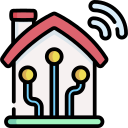AI-Based Thermostat Control
AI-based thermostat control leverages advanced artificial intelligence and machine learning algorithms to revolutionize how indoor climates are managed. Unlike traditional thermostats that rely on manual settings or rudimentary scheduling, AI-powered solutions continuously learn from user behavior, occupancy patterns, and external factors to deliver a customized, energy-efficient, and comfort-focused climate control experience. This technology represents a significant leap forward in home and building automation, promising not only reduced energy consumption but also enhanced user convenience and environmental sustainability.

How AI Transforms Climate Control
AI-based thermostats leverage sensors and historical data to recognize when spaces are in use and when they’re empty. Over time, they build detailed models that predict occupancy trends for each room or zone in a building. By identifying these patterns, the system intelligently reduces energy consumption during unoccupied periods and ensures optimal comfort just before occupancy resumes. This capability eliminates the waste associated with fixed schedules and enhances convenience, as homeowners and businesses no longer need to remember to adjust settings manually. The result is a climate control system that’s both smart and adaptive to real life.
Adaptive Scheduling
Traditional programmed thermostats rely on fixed schedules, which can quickly become outdated as lifestyles change. AI-based systems, on the other hand, adapt schedules automatically by continuously monitoring usage patterns and learning occupants’ routines. When family members alter their daily habits or when office hours shift seasonally, the AI seamlessly adjusts heating and cooling schedules to accommodate these changes. This adaptability ensures that energy is never wasted on empty rooms or during periods of absence, driving both cost savings and improved environmental performance.
Utility Demand Response Integration
Many power utilities offer demand response programs, where homes and businesses are rewarded for reducing energy use during peak demand periods. AI-based thermostats can automatically participate in these programs by pre-cooling or pre-heating buildings and temporarily relaxing setpoints to decrease load when requested by the utility. The AI coordinates these adjustments with user comfort preferences, ensuring minimal disruption. This synergy offers economic benefits to users while helping stabilize the grid and reduce reliance on less sustainable, high-emission energy sources during peak hours.
Long-Term Cost Analysis
Through continuous learning and performance monitoring, AI thermostats generate comprehensive reports on energy usage trends and cost savings over time. These insights empower users to make informed decisions about their climate control strategies and investments in additional energy-saving technologies. Businesses, in particular, benefit from transparency into usage patterns across multiple sites, enabling them to benchmark performance and prioritize upgrades. The long-term return on investment becomes evident as energy consumption and related costs decrease, making AI-based solutions a compelling choice for anyone seeking sustainable savings.
Modern AI thermostats offer intuitive control via smartphone apps and popular voice assistants, such as Amazon Alexa, Google Assistant, and Apple Siri. Users can adjust temperature settings, review energy reports, or create automation routines from anywhere, using natural language or mobile interfaces. The AI leverages these interactions to further refine its understanding of user preferences, ensuring ever-improving comfort. By bringing thermostat management into the digital age, these systems eliminate complexity while delivering greater control and insight for every user.
